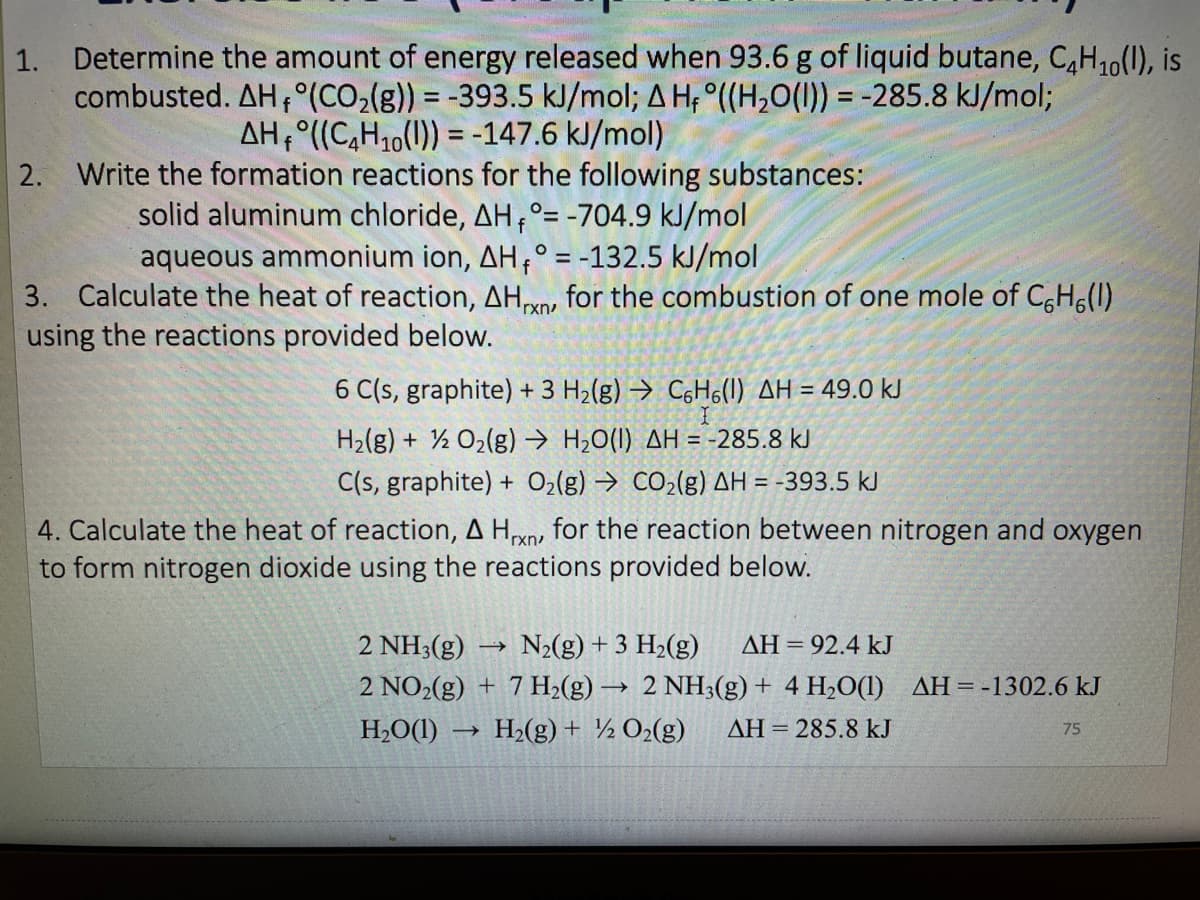1. Determine the amount of energy released when 93.6 g of liquid butane, C,H10(1 combusted. AH,°(CO2(g)) = -393.5 kJ/mol; A H; °((H20(1)) = -285.8 kJ/mol; AH÷°((C,H10(1)) = -147.6 kJ/mol) Write the formation reactions for the following substances:
1. Determine the amount of energy released when 93.6 g of liquid butane, C,H10(1 combusted. AH,°(CO2(g)) = -393.5 kJ/mol; A H; °((H20(1)) = -285.8 kJ/mol; AH÷°((C,H10(1)) = -147.6 kJ/mol) Write the formation reactions for the following substances:
Chemistry
10th Edition
ISBN:9781305957404
Author:Steven S. Zumdahl, Susan A. Zumdahl, Donald J. DeCoste
Publisher:Steven S. Zumdahl, Susan A. Zumdahl, Donald J. DeCoste
Chapter6: Thermochemistry
Section: Chapter Questions
Problem 68E: In a coffee-cup calorimeter, 1.60 g NH4NO3 is mixed with 75.0 g water at an initial temperature of...
Related questions
Question
Trying to solve #1 only

Transcribed Image Text:1. Determine the amount of energy released when 93.6 g of liquid butane, C,H,0(1), is
combusted. AH,°(CO2(g)) = -393.5 kJ/mol; A H; °((H,0(1)) = -285.8 kJ/mol;
%3D
AH,°((C,H10(1)) = -147.6 kJ/mol)
2. Write the formation reactions for the following substances:
solid aluminum chloride, AH,°= -704.9 kJ/mol
aqueous ammonium ion, AH,° = -132.5 kJ/mol
%3D
3. Calculate the heat of reaction, AH, for the combustion of one mole of C,H6(1)
using the reactions provided below.
'rxn
6 C(s, graphite) + 3 H2(g) → C6H6(1) AH = 49.0 kJ
H2(g) + ½ O2(g) → H2O(I) AH = -285.8 kJ
C(s, graphite) + O2(g) → CO2(g) AH = -393.5 kJ
4. Calculate the heat of reaction, A Hxn, for the reaction between nitrogen and oxygen
to form nitrogen dioxide using the reactions provided below.
2 NH3(g)
N2(g) + 3 H2(g)
AH = 92.4 kJ
2 NO2(g) + 7 H2(g) → 2 NH3(g) + 4 H2O(1) AH=-1302.6 kJ
H,O(1) -
H2(g) + ½ O2(g)
AH = 285.8 kJ
75
Expert Solution
This question has been solved!
Explore an expertly crafted, step-by-step solution for a thorough understanding of key concepts.
This is a popular solution!
Trending now
This is a popular solution!
Step by step
Solved in 3 steps with 4 images

Knowledge Booster
Learn more about
Need a deep-dive on the concept behind this application? Look no further. Learn more about this topic, chemistry and related others by exploring similar questions and additional content below.Recommended textbooks for you

Chemistry
Chemistry
ISBN:
9781305957404
Author:
Steven S. Zumdahl, Susan A. Zumdahl, Donald J. DeCoste
Publisher:
Cengage Learning


Chemistry: An Atoms First Approach
Chemistry
ISBN:
9781305079243
Author:
Steven S. Zumdahl, Susan A. Zumdahl
Publisher:
Cengage Learning

Chemistry
Chemistry
ISBN:
9781305957404
Author:
Steven S. Zumdahl, Susan A. Zumdahl, Donald J. DeCoste
Publisher:
Cengage Learning


Chemistry: An Atoms First Approach
Chemistry
ISBN:
9781305079243
Author:
Steven S. Zumdahl, Susan A. Zumdahl
Publisher:
Cengage Learning

Chemistry: Principles and Reactions
Chemistry
ISBN:
9781305079373
Author:
William L. Masterton, Cecile N. Hurley
Publisher:
Cengage Learning

Chemistry for Engineering Students
Chemistry
ISBN:
9781337398909
Author:
Lawrence S. Brown, Tom Holme
Publisher:
Cengage Learning

Chemistry by OpenStax (2015-05-04)
Chemistry
ISBN:
9781938168390
Author:
Klaus Theopold, Richard H Langley, Paul Flowers, William R. Robinson, Mark Blaser
Publisher:
OpenStax